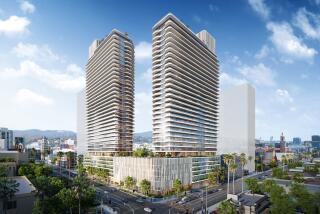He took downtown to a new place
- Share via
Almost 30 years ago, a young developer named Robert Maguire III came up with an audacious proposal for the greatest development project never built in downtown Los Angeles.
Responding to a request from the Community Redevelopment Agency for a plan for Bunker Hill, Maguire put together a team that included most of the leading architects and planners of the day. His idea was to combine a reconstruction of Bunker Hill’s historic urban fabric -- complete with apartment buildings cascading down alongside the Angels Flight funicular railroad -- with a few office towers.
Everybody agreed “A Grand Avenue,” as the proposal was named, was a spectacular plan for urban redevelopment. As a mixed-use and urban project, it was way ahead of its time. But nobody believed that Maguire had the financial wherewithal to pull it off. The CRA instead gave the project to Metropolitan Structures, then a leading developer of high-rise offices. It went on to build the prosaic California Plaza -- and went bankrupt doing so.
But no matter. Maguire had made his presence known -- and it wasn’t long before he set the tone for big-time development in L.A. in the 1980s. He was largely responsible for the downtown office landscape, which set the table for today’s condominium building boom. And although Maguire’s era of downtown office development has long since passed, his idea of combining business and civic activities in one project -- and one complicated deal -- lives on.
In a decade when nobody could envision the Grove or the condo-rich mixed-use projects that have characterized L.A. development since 2000, office buildings were king. And Maguire -- who was ousted by his own board of directors last month as chief executive of a real estate empire, Maguire Properties, in a dispute over the direction of the company -- gradually mastered the art of the complex urban-development deal by building strong relationships with corporations in need of lots of office space.
Maguire began as a builder of office structures for corporate clients. But he always understood how to leverage his clout. When I was a student at the UCLA architecture and planning school, I was selected to be a “Northrop Corporation Fellow.” Why Northrop had any interest in urban planning was beyond me, but many years later, I realized that Maguire was a big donor to the school and had strong-armed Northrop -- his first office-building client -- for a donation.
After “A Grand Avenue,” however, Maguire and his then-partners, Jim Thomas and Ned Fox, set out to build urban development projects in Los Angeles using corporate office buildings and other assets as their base. For instance, they bought the Pershing Square parking garage and worked with surrounding landowners to renovate the square itself. Later on, Maguire Thomas Partners pulled off the ultimate 1980s development deal -- the Library Tower project.
At 70-odd stories, Library Tower (now U.S. Bank Tower) was the tallest office building on the West Coast when it was built. But the tower itself was the least of it.
Under the city’s ordinary zoning rules, such a tall building would not have been permitted. But the city was thinking about tearing down the landmark Central Library across the street. In exchange for permission to build Library Tower -- and the nearby Gas Company Tower as well -- Maguire coughed up $140 million to restore the old library.
The CRA used the money not only to renovate the Central Library but to build an architecturally distinguished multistory addition -- it holds the stacks and drops several stories underground -- that has made the library one of Los Angeles’ great landmarks.
Maguire also hired the great landscape architect Lawrence Halprin to create Bunker Hill Steps, the landscaped stairway between the flats of Fifth Street on the south and Bunker Hill on the north.
Eventually, the office boom of the 1980s came to an end -- and the glitz associated with corporate office towers faded away, as the demand for such buildings weakened. In the last 15 years, Maguire has been gradually pushed out of the real estate limelight by such retail and mixed-use superstars as Rick Caruso, who built the Grove on the Westside and the Americana on Brand in Glendale. The developer wasn’t able to pull off his version of Playa Vista -- his typical office-based approach that relied on DreamWorks and other corporate clients -- and eventually the project was developed by others. Maguire had a reputation for being dictatorial, which might have been a factor in the board’s decision to oust him.
Even though he’s now in his 70s, Maguire will probably be back in some form. After all, wily developers have at least nine lives -- and they usually go bankrupt between each one. But he deserves credit for pioneering the office-based urban development in Los Angeles.
The next time you’re descending the stairs between McCormick & Schmick’s and Starbucks in U.S. Bank Tower and gazing at the expanded Central Library, think of Robert Maguire. His office building will probably go condo sooner than later, but the Bunker Hill Steps and the Central Library will forever be monuments to his deal-making genius.
William Fulton is a senior scholar at the USC School of Policy, Planning and Development and the publisher of the California Planning & Development Report. He blogs at www.cp-dr.com.
More to Read
Sign up for Essential California
The most important California stories and recommendations in your inbox every morning.
You may occasionally receive promotional content from the Los Angeles Times.






